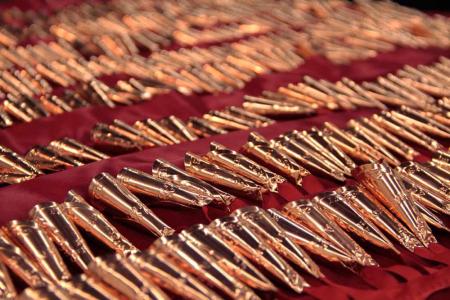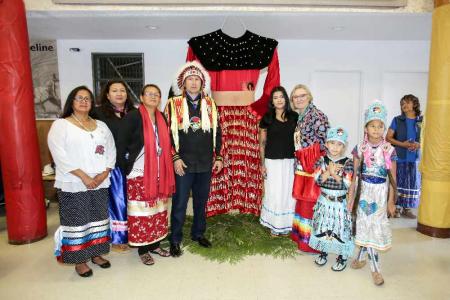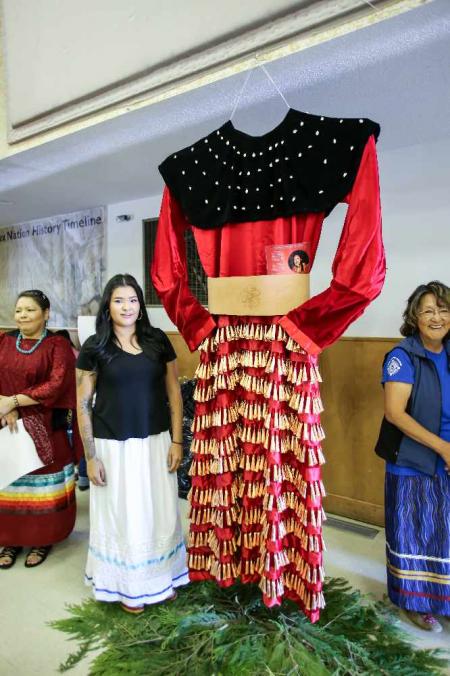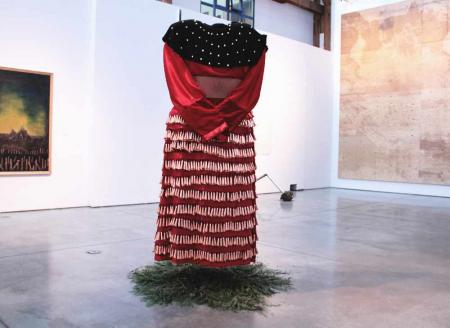Image Caption
{ALBUM_998702}
By Andrea Smith
Windspeaker.com Contributor
VANCOUVER
Chloe Bluebird Mustooch is a young artist who has been personally touched by the issue of missing and murdered Indigenous women and girls.
Her creation, a jingle dress called “1,200 Copper Tears”, which is installed at the Alexis Nakota Sioux Nation in Alberta, was made for her final art project for a visual arts degree from Emily Carr University in Vancouver.
The dress honors what was once estimated to be 1,200 murdered and missing Indigenous women across Canada, and to specifically honor her cousin and aunt, who are both, tragically, among them, a list which some have estimated now to be as many as 4,000 names long.
“What inspired me was… I wrote a couple of essays on this First Nations artist, Christi Belcourt. Her project was “Walking with our Sisters.” She has thousands of vamps from moccasins that people send in to her to represent women that were missing and murdered. It’s a very powerful exhibit and very ceremonial,” said Mustooch.
“What inspired me to want to honor these women is because I have experience with family members that are missing and murdered… And there’s still no answers for that, so that’s kind of where I began,” she said.
Mustooch is 25 years old, and along with completing her arts degree last April, she is a very recent graduate from a graphic arts program at the B.C. Institute of Technology.
It was seven years ago, just after her high school graduation, that her cousin, Jaqueline Lucille Bruno, age 18, disappeared and was found murdered the next day.
“I was attending my reserve’s grad banquet for all of the high school grads…. This happened to be the night she was murdered. It was a Friday night and we received the news Saturday night. Sadly, it was exactly a week from her 19th birthday,” said Mustooch.
Then, five years later, her aunt went missing. The disappearance of Misty Potts was more widely written about in the news than was Mustooch’s cousin, because the issue of murdered and missing Indigenous women was finally coming to public attention. But Potts has never been found, and both of these cases remain unsolved.
Mustooch’s “1200 copper tears” jingle dress represents a way to approach the issue, while putting something positive into the world about something otherwise awful. Included in her design are items used in traditional ceremonies, bringing a sense of healing, which is central to the jingle dance itself.
“I chose 1200 jingles to represent a prayer for each missing and murdered Indigenous woman,” said Mustooch.
“The amount of jingles there represents a human being that’s no longer here with us. Because you always hear about these numbers and people don’t really have that connection. And I chose red, of course, for the Red Dress campaign,” she said.
Mustooch includes one other feature, which adds to the sense—or hope—of healing.
“I lay cedar under it…Because I also wanted it to seem ceremonial in a way. So it’s offering the medicine and promoting healing towards each jingle to be like a prayer,” she said.
Mustooch was in Vancouver while building the dress, the home of some of the most notorious cases of violent crime against Indigenous women. She used cedar specifically because it was respectful to the territory she was on at the time.
Along with the features already mentioned, there is also a leather belt embossed with a flower, and a black shawl, with cowrie shells. And though you can’t quite tell in photographs, the dress is actually seven feet high and four feet wide. The reason for this is to emulate something that would fit Sabe—a Cree word for Sasquatch, said Mustooch.
“It’s that the women are missing… You don’t get to see them. They were kind of invisible to the government of Canada, and to the larger population, you know. No one really cared about this problem,” said Mustooch, likening it to how though Sasquatch is big, he is still a mystery.
Mustooch is currently working for the Alexis Nakota Sioux Nation in the Heritage and Language department. Last week she was able share her dress at a meeting with chief and council, and the Minister of Indigenous and Northern Affairs Carolyn Bennett.
The minister was teary eyed after seeing the dress and talked about the issue of missing and murdered Indigenous women and girls, said Mustooch, who would like to see her dress travel and touch others in the same way.
Mustooch’s mother, Ruth Mustooch, also an artist, has been helping her daughter cultivate her many talents since she was a child. She would also like to see this piece of her daughter’s work be embraced by larger audiences.
“She worked so long on it. From October to April. So it’s all hand-stitched. It’s a prayer for each of these women. As she was doing it, that’s what she was thinking,” said Ruth Mustooch.
“I guess it’s her hope that people will think about that. And for the larger society to think about these people… To say a prayer, and think about the families,” she said.






